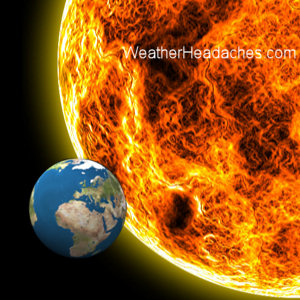Having looked at the cause of weather headaches in the previous article, we will now focus on weather headaches and the weather. Weather and air pressure are intimately linked and the result of their interaction not only determines the weather but the risk of headaches in someone who is weather sensitive.
What is air pressure?
Air pressure refers to the force exerted by the weight of air above an object, it is measured using a barometer and can be represented in various units such as Millibar (mbar), inches or millimeters of mercury (inHg or mmHg) and Kilopascals (KPa).
Why does air pressure change?
Difference in air pressure result from the way in which the sun heats the Earths surface and this is affected by the angle of the earths rotation and the seasons of the years. These factors, combined with the Earths surface being uneven and covered in both land and water masses, result in a very dynamic and constantly changing distribution of air mass i.e. non-uniform.
High pressure refers to when the column of air above a given place is greater than average i.e. more weight/pressure, and low pressure is where the column of air is smaller than average i.e. less weight/pressure.
The situation is complex because moisture, altitude and temperature all interplay with, and affect air pressure. It is for this reason that the:
- Equator is associated with lower air pressure i.e. warm and moist air is less dense and tends to rise.
- Earth’s poles are associated with higher air pressure i.e. cold and less moist air is more dense and tends to sink.
How does understanding air pressure help me with my headache?
Changing air pressure is associated with changing weather patterns. By comparing the onset and intensity of your headaches with air pressure readings taken over a period of time, it is possible to reveal what specific patterns of air pressure are likely to trigger your headaches.
In addition, you will also begin to ‘tune in’ to the weather and have a good idea whether you are likely to experience a headache. For example, if you are sensitive to:
A rising trend in air pressure or high pressure, you will find this situation can occur:
- Following a storm, or
- When there are clear skies, or
- In winter time (if there has been frost) it indicates possible oncoming snow.
A falling trend in air pressure or low pressure, you will find that this situation occurs:
- As a storm approaches, or
- During a storm, or
- When the weather is generally poor and wet.
What are the most common air pressure/weather conditions that lead to headaches?
Unfortunately, the air pressure/weather pattern, sensitivity, type and severity of headache experienced by weather sensitive people varies considerably between individuals. It is often found to be caused by trending or changes in air pressure/weather. This is why determining whether a person suffers from weather headaches and under what conditions they occur will involve the individual keeping a headache diary that notes the weather and air pressure over a number of months.
Having previously considered the symptoms and cause of weather headaches, the article following weather headaches and the weather will look at treatment for weather headaches, in particular the importance of keeping a headache diary.
